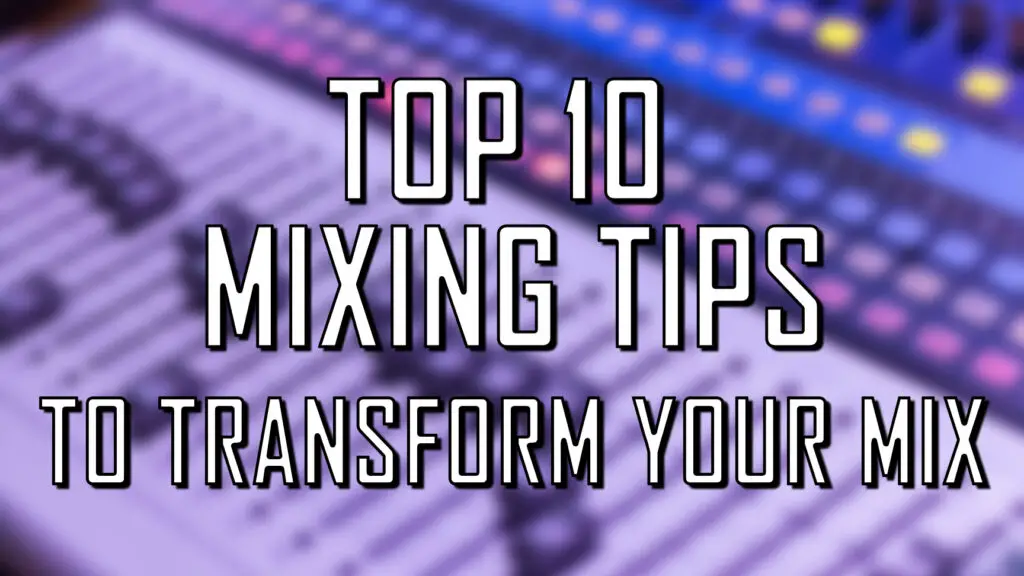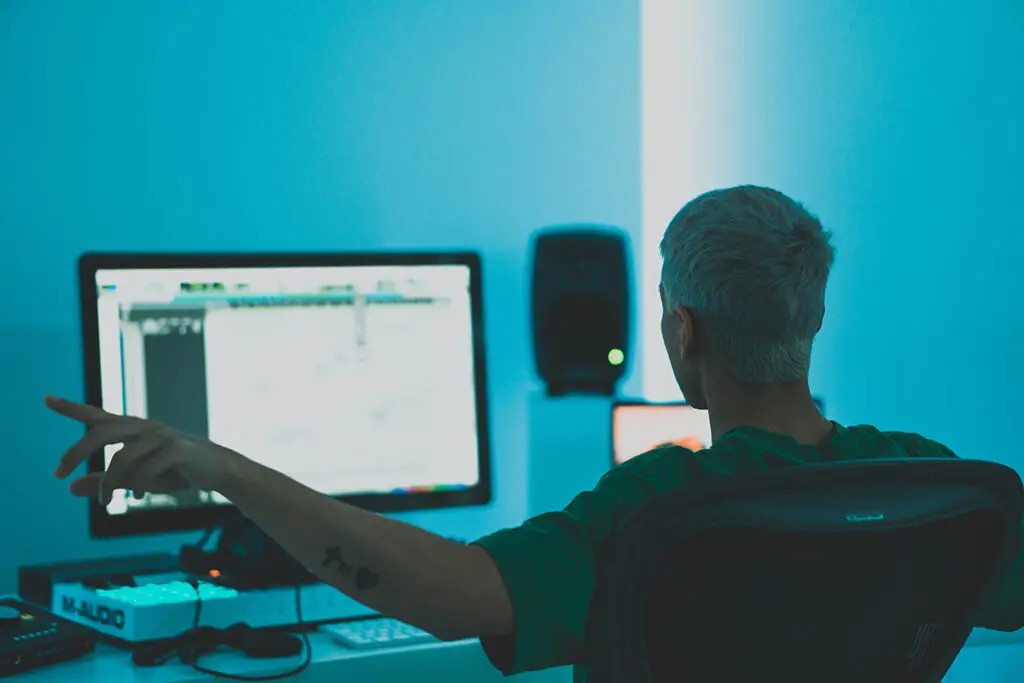Top 10 Mixing Tips that will TRANSFORM your Final Track (2022)

Learning how to mix a track is an essential part of music production, as a bad mix can completely ruin an otherwise incredible track. Trust me, I’ve seen it many times.
If you’re relying purely on trial and error, mixing a track can be an extremely infuriating process. For beginners, this can lead to hours of wasted creative potential, and the final mix may still sound terrible.
When I first starting producing music, I dreaded the mixing stage. I’d feel overwhelmed, and completely disheartened by my results. Luckily there are many fantastic mixing tips and techniques that apply to almost every mixing situation and music genre (that I wish I’d known at the time!).
So below are my top 10 mixing tips that will transform your tracks, and help you achieve an outstanding, professional-sounding final mix. Enjoy!
Please note: These tips are mainly aimed at beginner / intermediate music producers, although more experienced producers may also find some value here.
Mixing Tip #1 – Make sure your input material is as high quality as possible
While it is true that a good mix can transform a track, you should always make sure your source recordings and samples are as good as possible first.
Don’t create music assuming you’ll “fix it in the mix”. A perfect mix won’t fix a sub-par instrumental performance, or a low quality MP3 sample. Your sounds need to be as high quality as possible before the mixing stage.
For example if you’re recording a guitar part, but your mic placement is too far away, and there’s background noise and other audio imperfections. In this situation you’re probably better off creating a more professional recording setup than trying to fix these details in the mixing stage.
Another example is finding the right drum samples. If you’re creating modern hip hop, but you’re using default, low quality, overused kick sounds, there’s plenty of incredible hip hop sample packs out there that will take your tracks to a whole other level.
Technically, this isn’t a mixing tip, but it’s a surefire way to speed up and simplify the mixing process.
Mixing Tip #2 – Balancing before anything else
Volume control is one of the most critical parts of mixing a track. Before moving onto compression, EQ etc, make sure your track is well balanced first.
The volume balance of an individual instrument or vocal track will impact how much additional mixing is needed.
Another crucial element to consider here is volume automation. For example, if you have a track with a synth melody that plays through the entire track, it may need a completely different volume level in the verses than in the chorus/hook sections of a song.
Don’t worry about other mixing processes until the volume levels are where they need to be throughout the track, as adding things like compression can actually be counterproductive if the balancing is off.
Mixing Tip #3 – Minimise using the Solo button
When mixing a track, perspective and context are key. Don’t spend hours EQ’ing each individual solo’ed element of a song, and this won’t provide you with the context of the entire mix.
For example, let’s say you spend ages EQ’ing a bassline with the bass track solo’ed. You may get to a point where the bass sounds amazing when played on its own. However, when you bring in other elements such as kick drums, synths, pads etc, this might completely clash with the bassline, and you’ll end up having to EQ it again with the context of the mix.
If you’re used to EQ’ing everything in solo, this is often a difficult switch to make. As with almost everything in music production, practice is key, and if you get good at this concept your final mixes will improve dramatically.
So remember: avoid that solo button.
Mixing Tip #4 – Use busses
Tip #5 is to create busses. I cannot stress how important this is to speeding up the mixing process. In short, a bus (or: buss) is a signal path which can be used to group several individual audio tracks together. These individual tracks can then be manipulated, as a group, like another track.
Once you have your blend, bus certain groups of tracks together. Some common examples of bus tracks are drums, guitars, percussion, basses and keys, but it’s really dependant on the track itself. This will give you a whole other level of control over your mix, allowing you to compartmentalize the macro elements of the track.
Mixing Tip #5 – Mix the “climax” first
This is an often overlooked mixing tip, and was definitely a game-changer in my mixing journey.
If you start mixing a track from the intro, the verse, or any low point in the song, this makes it significantly more difficult to properly mix a chorus or larger hook section.
Let’s say you mix a song starting by looping the chorus. Once you achieve a great mix, it’ll be easier to move to the verses as you can began taking out elements and adjusting accordingly. This takes a more “subtractive” approach to mixing your track. However, if you start by mixing a verse, sure the verse may sound great, but it’ll become very difficult to bring in multiple elements at the chorus/”climax” of the song without destroying the mix.
So remember, mix the climax of the track first.
Mixing Tip #6 – Reference Tracks
Ear fatigue is real guys, so it’s important you’re comparing your mix with other similar, professionally mixed tracks in your genre. This process can really highlight certain frequencies or elements that need some extra work.
A lot of beginner producers despise this advice, as comparing your mix against a professional master can be very disheartening at first. However, being honest with yourself and understanding where your skill-set is currently at is crucial.
When comparing your mix to a reference track, it’s likely you’ll notice something glaringly obvious that needs fixing, like your bass is way too loud, or the vocals sound “buried” in the mix. More often than not, without a reference track you’d be none the wiser.

Mixing Tip #7 – Take a break!
This one is pretty self explanatory. Studies show that over the course of several hours, you are usually more productive if you are taking regular breaks.
This is especially true for mixing. Don’t wear yourself out by mixing the same drum track for hours on end. Whether it’s going on a walk, taking a cold shower, working on another track, do whatever works for you.
Just make sure you’re giving your ears a break, they’ll thank you for it.
Mixing Tip #8 – Research, not reliance
There are plenty of EQ cheat sheets and guides for achieving the “perfect kick drum” or a “crispy snare”. Do these guides work? To an extent, yes.
When it comes to audio mixing, it’s important to do your research. There are literally hundreds of in-depth Youtube videos showing you how to mix effectively in your DAW. I consider this EQ cheat sheet from Produce like a Pro a good starting point for understanding how different EQ frequencies will shape a specific sound.
Having said that, don’t completely rely on these kind of guides. Every mix is different, for example you’d never mix a lofi hip hop kick drum using the same mixing techniques as a house kick drum. As you get better at mixing, you’ll start to rely on guides / tutorials less and trust your intuition more.
Mixing Tip #9 – High-Pass EQ is your friend
Using high-pass filters properly is a fantastic technique for removing unwanted noise and audio artefacts such as AC or rumble. A high-pass filter is a simple, but effective EQ curve that removes unwanted low frequencies from an audio source. This becomes particularly beneficial when you’re working on vocals or other recorded audio tracks.
By adding high-pass filters, you are opening up the low end and giving things like the bass and kick drums room to breathe.
Mixing Tip #10 – The “Car Test”
Just because a mix sounds great on one set of speakers, doesn’t mean it’ll sound good on another.
Have you ever made a track you’re really proud of, played it through a friends speaker, only to be horrified at how completely different the track sounds?
Make sure you’re testing your mix through various speakers; a car stereo, a friends setup, your phone speakers and even through headphones. This will give you a good scope of how your track will sound in different environments, not just your home studio speakers.
Top Mixing Tips: Similar Articles
How to make a beat in FL Studio
How to use Serum (For Beginners)
